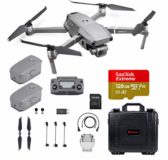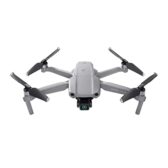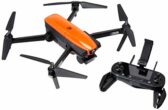The 9 Best Videography Drones for Unreal Aerial Films
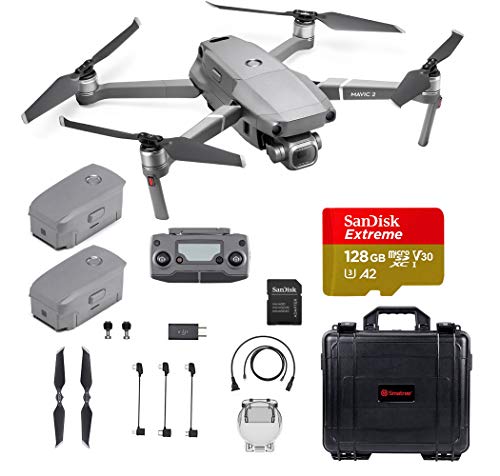
DJI Mavic 2 Pro
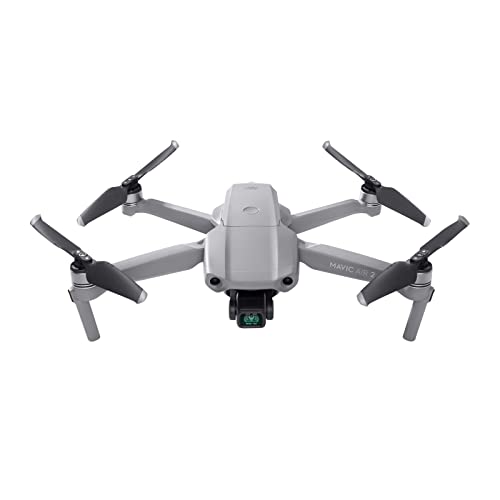
DJI Mavic Air 2
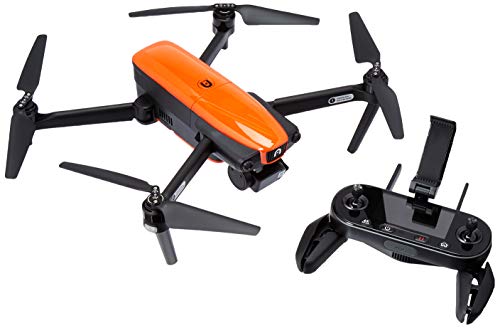
Autel Robotics EVO
Watch a movie nowadays, and chances are you’ll stumble upon a fantastic aerial shot, usually of the city or town where the film takes place.
That used to take thousands of dollars to shoot with complicated equipment that needed an entire crew.
Nowadays, a $500 drone will do an even better job at a fraction of the time. Such is the possibility with today’s technology!
And if you want to make your very own Hollywood level shot, let us guide you with the best video drones you can buy in the market today.
We’ve rounded up a whole selection of the best drones for cinematography in this post. But first, let’s talk about some of the most important things that you should be looking at when buying in this area.
What Makes A Good Video Drone?
Shop around for video drones, and it’s easy to get lost in all the features and jargon. This is especially true if you haven’t bought a drone yet in your life.
But it’s easy to sift through all that noise when you know the end result that you want. And with video drones, it’s always to get the best possible footage quality that you can afford.
Then it’s just a matter of choosing the best specs that give you that desired result.
Most of what makes a good video drone also applies to a photography drone. If you’re at least familiar with photography specs, then you’ll have an easier time shopping for a video drone.
So what makes a good video drone? Here are some specs you have to take into mind:
Camera Resolution
Whenever you see a video camera advertised online, it will almost always start with this spec. The resolution simply means the amount of detail, or pixels, your drone camera can capture.
Let’s talk about pixels for a second. Any digital image, be it a photo or video, is made up of millions of tiny squares called pixels. You can see this clearly when you try zooming in on image until it looks like a mosaic, or “pixelized” as the term goes.
Each pixel represents a single color that forms the illusion of a complete picture when you zoom out enough. Image the detail you get from a picture with just 4 pixels (it will look abstract) to one with millions of them.
Thus, the higher the resolution, the more pixels are involved, and you get a more detailed image. Resolution is specified in a number that refers to how many pixels there are in either the horizontal or vertical dimensions of the footage.
Let’s start with the most common resolution – HD. This comes in two variants, 720p and 1080p. The number refers to the vertical dimension of the image. So 720p has a pixel size of 1280 x 720, while 1080p is 1920 x 1080.
Then you come to sizes beyond HD – 2K and 4K. When you start referring to these resolutions, the number now refers to the horizontal dimensions of the footage. Confusing, I know.
4K can capture video dimensions that are roughly 4,000 pixels wide and 2,160 pixels high, although this varies slightly with camera manufacturers. 2K is at around 2,000 pixels wide and 1,152 pixels high.
Now, while resolution influences video quality, it’s not the most crucial factor. In fact, it’s not even a reliable indicator.
The reason is this: resolution only tells you the amount of detail your video camera can capture. It tells you nothing about how it actually does that. If your camera does a poor job at capturing video, then no amount of resolution will save that. All you’ll end up with is a high-res but crappy image.
So here’s an insider tip: look at the other specs that contribute much more to image quality than resolution. That’s the real secret to achieving stunning footage with your video drone.
Let’s look into a few of these.
Sensor Size
The real powerhouse of any camera is the sensor. It’s the reason why a more expensive 4K camera will produce vastly superior footage than a cheaper 4K one. The resolutions are the same, but the better camera will usually have a larger sensor.
Sensors are the ones responsible for recording the actual image we see. The light that comes in from the lens hits and becomes “imprinted” in the sensor. The processing unit then translates this into color and tone information, forming our picture.
Sensor size is one of those cases where bigger is better. A larger sensor will be capable of recording more light data, leading to an overall more defined image. The colors are more vibrant and more defined, the details are crisper, and you get less noise during low light conditions.
The vast majority of drones, especially the higher-end ones, use the CMOS sensor. At the lower end, you’ll get sizes in the 1/3 to 1/2.3 inch range. For comparison’s sake, an iPhone 7 would have a 1/3 inch sensor.
Consumer drones with exceptional image quality will have sensor sizes of 1 inch. The DJI Phantom and Mavic 2 Pro are prime examples. Professional quality drones used in high-end productions will usually reach 4/3 inch sensor sizes.
For the casual user, however, a sensor size of less than 1 inch should be enough. The only time you would want a bigger sensor is when you regularly take videos in low light, as it would produce less grainy footage.
Field of View (FOV)
Field of view (FOV) refers to how much of the environment a camera can “see” and capture. You’ll usually hear photographers refer to these in terms of “wide-angle” or “fish-eye”.
FOV is measured in degrees. A wider FOV at around 120-130 degrees would mean the camera can see a more significant, “zoomed out” view. This is perfect for shooting landscape footage as it makes it look grander. Wider FOVs, however, might produce some distortion along the sides of the footage.
A wide FOV is also desirable when using First Person View (FPV) mode. It allows you to see more of what’s in front of you, allowing you to react and fly better.
At the extreme, an excessively wide FOV will give you a “fish-eye” effect. This is when the sides of the image get bulged and distorted, like looking through the eyes of a fish. While generally not desirable, some deliberately want this as an artistic effect on their footage
Narrower FOV will have more of a zoomed effect. It’s excellent for shooting portraits or subjects in tighter spaces.
A thing to remember is that FOV is mostly a matter of personal preference and shooting style – there’s no “right” or “wrong” FOV. If you love shooting landscape videos, then a wider FOV will serve you well. Otherwise, for selfies or portrait shots, narrower is better.
Frame Rate
When you break it down, video is nothing more than still images shown in rapid succession. It’s similar to how drawings in flip books work. When shown at a fast enough rate, it creates the illusion of movement.
The individual still images in a video are called frames, and the rate at which this is shown or “flipped through” is called the frame rate. The standard frame rate is 24 fps or frames per second. This means that, in a second, 24 distinct images are shown to the viewer, creating the illusion of a movie.
Why 24 fps? It’s merely the speed the brain sees the world. Hence, most films are shot and played at 24 fps, because it gives a more realistic, cinematic experience. TV usually uses 30 fps, since it’s much smoother.
Most drones, however, are capable of faster frame rates like 60 or even 120 fps. But if 24 fps is the standard, why would a faster frame rate matter?
The usual reason for picking a higher frame rate is when you want to shoot in slow motion. By packing in more frames per second, you’ll be able to slow it down while still retaining smooth motion. If you attempted to do that to 24 fps video, it will look jittery and not at all nice.
Higher frame rates are also recommended if you’re shooting scenes with lots of fast action, like sports events, so the details remain crisp and defined.
For the casual user, a frame rate of 24 or 30 fps is more than enough. If you want to experiment with timelapse photography, 60 fps is a good place to start.
Camera Stability
A stabilized camera is an essential factor for taking crisp photos, but it arguably matters much more when shooting videos. This is the job of the gimbal.
This is a mechanical device that cradles your drone’s camera and is capable of rotating independently of the drone. Whenever it’s in flight, the gimbal will try to detect the drone’s movement, and rotate the camera around to cancel out that movement.
The result is that the camera stays steady, allowing you to take a continuous smooth motion that’s crisp and defined.
Gimbals have one of the biggest influences on video quality. They are the secret to those amazing looking fly-by videos. It’s what gives your footage that smooth, cinematic feel that doesn’t seem like it was shot with a handheld camcorder. This is especially true if you fly your drone manually.
So, try to get a gimbal-mounted camera if you can. It will do wonders for your video!
Flight Performance
If you want to achieve those smooth aerial videos, then having a drone that flies fantastically is crucial. Even if your shooting stationary footage like a panorama, you’d still want the drone to be able to hover stably in place to make your videos as smooth as possible.
Look for video drones that are responsive and can hold their altitude well. Intuitive controls are also essential, especially if you plan to execute complex flight paths manually. Gimbals can only do so much, so you need a smooth flight to create equally smooth videos.
You also want to consider autonomous or assisted flight modes, like Follow Me or Waypoint. These make creating complicated moving shots reasonably easy.
The Best Drones for Recording Videos
We may receive compensation on qualifying purchases via our links. This does not change how we review items. For more information, please read our affiliate disclosure.
Arguably the best drone around for videography — and for everything else, too.

- Flight Time: 30 minutes
- Range: 7 kilometers
- Camera: 4K resolution at 30 fps; 20 MP stills
- Weight: 1.64 pounds
- Gimbal: 3 Axis
The Mavic 2 Pro is, by far, one of the best video drones in the market. While it shines in true DJI fashion, where the Mavic 2 Pro truly excels is in the video quality it’s capable of.
The Pro is actually one version of the Mavic 2, the other being the Zoom. While both have almost identical features, the Pro has a way better camera. In fact, it’s one of the best cameras ever to grace a compact consumer drone.
The Mavic 2 Pro has an impressive Hasselblad L1D-20c 4K camera, with a large 1″ CMOS sensor. It’s mounted on an enhanced version of DJI’s 3-axis gimbal, giving it accurate stabilization capabilities.
The video quality of the Mavic 2 Pro has to be seen to be believed. It features jaw-dropping color definition and range, with smooth playback. Everything is crisp and clear, even with dramatic movements.
You get greater control over your shots by allowing you to adjust the aperture from f/2.8 – f/1.1 This is something that pro videographers will surely appreciate.
The camera also supports HDR video, giving much more realistic colors and tones when plugged into a 4K TV with HLG.
You can also do some neat new tricks with the Mavic 2 Pro, and one of them is Hyperlapse. It allows you to shoot stunning looking time-lapses from the drone itself, without the need for any post-production.
Flight performance-wise, expect it to be at usual DJI levels. Controls are ultra-responsive, and flying it feels very natural. The autonomous flight modes are great to assist you in creating awesome looking fly-by videos, with obstacle avoidance to make it even safer.
Overall, the Mavic 2 Pro is THE best video drone to get. It just exceeds in every department and is worth having if you can afford it. Sadly, its most significant drawback is that its expensive.
+ Pros
The Mavic Air 2 is a groundbreaking development in the mid-budget range. Almost no other drone compares for the price.

- Flight Time: 34 minutes
- Weight: 1.3lbs / 0.59kg
- Camera: 48MP with 4K/60FPS video
- Range: 10km / 6.2 miles
The DJI Mavic Air 2‘s quality isn’t much of a surprise to anyone that knows the drone space — we’ve been blown away with what this machine is capable of considering it falls way below the $1,000 price tag that is usually required for such a premium product.
Its 34 minutes of flight time is staggering given its size and price, making it one of the biggest battery life drones you’ll find.
The Mavic Air 2 has obstacle detection in three different directions and intelligent tracking, along with DJI’s ActiveTrack technology, to also make this one of the best bang-for-the-buck follow me drones that there are.
With a 48MP 1/2-inch CMOS sensor camera and 4K video supported by a 3-axis gimbal, this is a brilliant option for anyone looking to take premium quality photos and videos without having to spend an arm and a leg.
+ Pros
- Cons
Our favourite non-DJI drone in the market. The EVO from Autel Robotics creates incredible videos.

- Flight Time: ~30 minutes
- Charge Time: ~210 minutes
- Range: 7050m / 4.4 miles
- Remote Controller: WiFi 2.4GHz (included in the set)
- Camera: 3-axis gimbal 4K 60fps camera with 12MP
- Live Video Transmission Range: 7000m / 4.3 miles
- Weight: 863g / 1.9lbs
- Carry Capacity: N/A
- Working Temperature: 0°C ~ 40°C
- Rated for outdoor use
Sporting a quality camera and plenty of smart flight modes, the Autel EVO is one of the best videography drones to get. Everything about the drone is designed to help you get the best looking aerial shots possible.
The EVO comes with a 4K camera that’s capable of capturing up to 60 fps. It also has an Ambarella H2 image processor onboard, giving the video output a much better dynamic range.
In practice, what this all means is that you get incredible looking footage with the EVO. It’s crisp with great definition and smooth color gradients.
The 3-axis gimbal works exceptionally well, as evidenced by the jitter-free fly by sample video we did that looks straight out of a Hollywood movie. And we tried to really break the stabilization by dramatically moving the drone around. Even with all that excessive movement, though, the footage still looked relatively stable.
The EVO’s autonomous flight modes are also commendable and are actually one of its better features. You can use modes like Follow or Parallel to create incredible looking aerial videos, without having to control the drone manually.
It uses a proprietary visual recognition technology called Dynamic Track, which is accurate enough to stick with you even with fast movements.
The 30 minutes of flight time gives you plenty of time to plan out and execute complex cinematographic shots. Plus, the long 7 km range allows you to go farther to capture really majestic views.
For serious videographers, the Autel EVO is a fantastic choice if you don’t want to go to the DJI route. While not exactly cheap, it makes up for it with exceptional video and flight performance.
+ Pros
- Cons
GPS, 4K video and a staggering 21 MP. This extended version also gives a combined flight time of 1 hour 15 minutes!
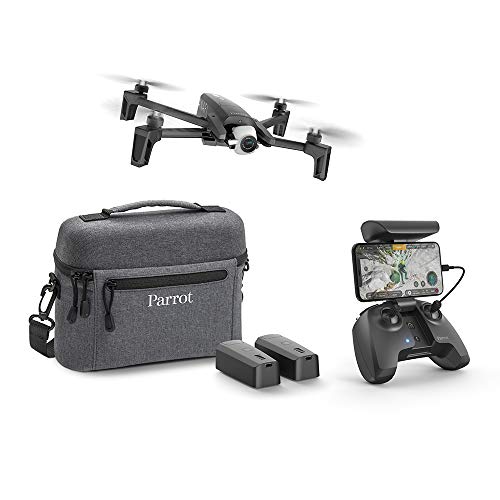
- Flight Time: ~75 minutes (combined)
- Charge Time: ~240 minutes (per battery)
- Range: 4000m / 2.5mi
- Remote Controller: WiFi 5.4GHz & 2.4Ghz (included in the set)
- Camera: 180° adjustable f/2.4 ASPH lens 4K Camera with 21MP
- Live Video Transmission Range: 4000m / 2.5mi
- Weight: 320g / 11.28oz
- Working Temperature: -10°C to 40°C
- Rated for indoor and outdoor use
In the body, the Anafi is a fully developed GPS drone with everything you would want from autopilot. It can follow waypoints, focus on the drone pilot, or circle around for a 360 shot. It also has geofencing to prevent you from flying over places you shouldn’t be.
Because it weighs only 320 grams, it’s highly portable. It also has useful features like return-to-home where it will return to where it took off from in the press of a button.
But, the real centerpiece of this drone is the camera.
With the HDR f/2.4 lens, it will take professional videos from the skies. Even in 4K, there is minimal wobbling, keeping the video steady even in turns. If needed for any reason, you can bring the resolution down to 2k or 1080p full HD.
On top of that, it also sports an enormously impressive 21 MP (yes, twenty one) camera that can even take burst shots of up to 10 photos per second.
Even casual videos with the Anafi become amazing, while travel vlogs become a true piece of art and anything above that can truly take on a new life.
To top things off, the camera can also swivel a full 180 degrees in flight to get or maintain the perfect shots.
With up to 1 hour and 15 minutes of combined flight time with the Anafi Extended, this is ideal for anyone to looking to make awesome short films and even feature-length productions.
It’s worth noting that the drone has quite a few negative reviews on Amazon, though most of these are actually aimed at the customer service of the company rather than the product itself.
+ Pros
- Cons
No products found.
4K video, 12MP photos and 25-minute battery life for stunning aerial shots.
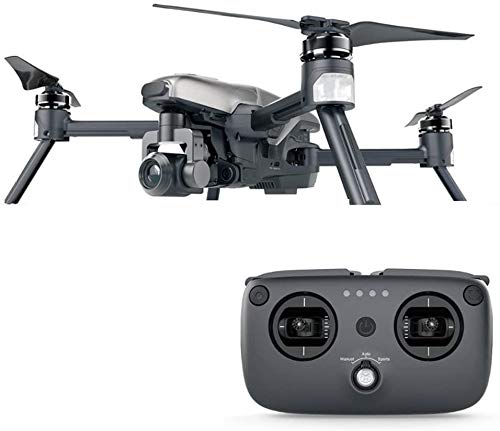
- Flight Time: 28 minutes
- Camera Resolution: 4K UHD
- Sensor Size: 1/2.3 inch CMOS
- Frame Rate: 30 fps and 60 fps
- Gimbal: 3-axis with 90-degree adjustable angle
- Weight: 890g
Known primarily for their racing drones, Walkera nevertheless came out with a powerful drone for recording videos, the Vitus 320. It’s a compact and foldable UAV, with plenty of flight features.
Let’s take a look at the video quality. The Walkera Vitus 320 sports a 4K UHD resolution camera, paired with a 1/2.3 inch CMOS sensor. This allows it an ISO range of up to 12,800, giving it plenty of leeway in low light conditions.
Video quality is particularly impressive. Thanks to its equipped 3-axis gimbal, video capture was buttery smooth, even while we were zipping around the place. The 85-degree FOV is a standard narrow range, although we would’ve preferred a wider one for its supported FPV mode.
The video quality is way above average and is comparable to a DJI Mavic Pro model.
Flight performance-wise, there’s a lot to be had. Equipped GPS/GLONASS dual positioning is much more accurate when using features like Altitude Hold and GPS Return, even when signal quality is poor.
Enhancing its performance are the onboard infrared sensors and optical flow camera. Aside from powering the Vitus 320’s flight stability, it’s also responsible for its robust 3-way obstacle avoidance system, able to detect obstacles up to 8m away.
When used with its intelligent flight modes, this makes autonomous tracking that much safer to use with Vitus 320.
The most unique thing about this drone has to be the VR compatibility. Sure, lots of drones are VR compatible, but the Vitus has a dedicated app with augmented reality games; collection, combat and racing. So. Cool.
+ Pros
- Cons
No products found.
The Mavic Mini has replaced the hugely popular Spark model and will become one of the most popular drones of all time.
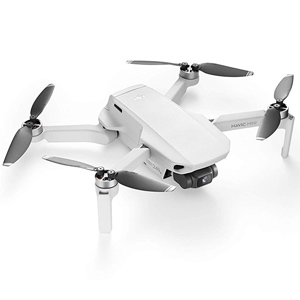
- Flight Time: ~28 minutes
- Charge Time: ~90 minutes
- Range: 3000m / 9842ft
- Remote Controller: WiFi 5.4GHz & 2.4Ghz (included in the set)
- Camera: 3-axis gimbal 2K Camera with 12MP
- Live Video Transmission Range: 2500m / 8200ft
- Weight: 249g / 8.78oz
- Working Temperature: 0°C ~ 40°C
- Rated for indoor and outdoor use
The specs on the DJI Mavic Mini are nothing we haven’t seen before from DJI products, but never in this small of a size.
The full diagonal distance of the drone is just above 8 inches, with the base being even smaller. Generally, even a child could hold the Mavic Mini comfortably in their palm. Landing and takeoff from the palm are also the best way to operate it.
Other features follow the DJI standard. The drone is exceptionally easy to operate and has all of the autonomous features as its larger cousins.
The controller does give more range to your device and has that tactile feel. But, if you want to use the Mavic Mini with just your smartphone, that is possible as well. The DJI Fly app is one of the best drone apps available.
What most people will be interested in is the camera, and that is where this model shines. The 2K camera has a 3-axis gimbal and an 83° FOV angle. As the camera can swivel up to 90°, it will give you a wide range of filming options.
The CMOS chip may only have 1/2.3” (6.17mm by 4.55mm) but comes with 12MP effective pixels. This would make the DJI Mavic Mini one of the best smartphone cameras available, but also the one that flies.
Ability to autonomously follow your face, your friends, and any area you designate will allow you to get some genuinely cinematic shots with your drone.
Professional photographers will see the low ISO capability and low frame rate in 2K, but for most other users, there will be no issues.
The DJI Mavic Mini can become a primary tool of many vloggers, YouTubers, and Instagramers. And, for any experienced drone pilot, they will be a lot of fun and a great experience to fly.
+ Pros
- Cons
The Holy Stone HS120D is a good low-budget choice for amateur videographers to try mastering drone footage in full HD.
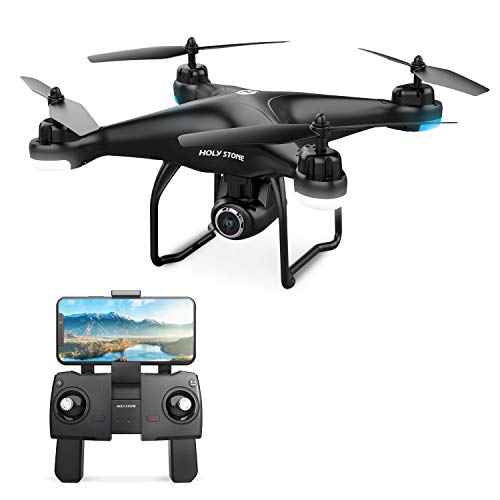
- Flight Time: 18 minutes
- Camera: 1080p HD with 120-degree FOV
- Gimbal: none
- Weight: 221g
The Holy Stone HS120D is one of the better cheap videography drones out there. Even at this price, it still has some excellent features for the aspiring film maker.
The camera installed in the HS120D is a 1080p HD camera with a 120-degree FOV. It’s great for giving a broader view when flying the drone around, but it’s not as good when taking photos. In fact, the photo quality for the HS120D is mediocre at best.
Fortunately, video quality fares a little better. It’s better defined and not as muddled and blurry as with still photos. However, the absence of a gimbal can make the footage pretty jerky sometimes, especially if you’re stopping and starting, or operating in windy conditions.
This means you have to be very careful when piloting your drone and recording at the same time. You’ll be pretty much restricted on the types of movements you can do, without introducing a lot of shake and jitter into the shot, but drones are best used for slow panoramic sweep shots, right?
To be fair, this is the norm and not the exception at this price range. When judged by this, we’d say the video quality is pretty decent.
The HS120D’s flight performance is where it excels. It’s one of the rare budget drones that can reliably hover in place without much effort.
The GPS module also makes possible some useful safety features like Auto Return and Follow Me. For creating complicated paths, you can try the TapFly feature in the mobile app. It allows you to draw a custom route for the HS120D to follow.
For the price range, the Holy Stone HS120D delivers. It might not be 4K, but the 1080p HD camera captures decent video. 4k can sometimes be an increased burden; actual performance can be worse due to the need for increased processing power. 1080p is perfect for this quadcopter.
Where this drone shines is in the autonomous and beginner-friendly flight capabilities for those wanting to film as an amateur drone pilot.
+ Pros
- Cons
A fast, affordable drone with decent battery life, capable of recording 2K video footage.
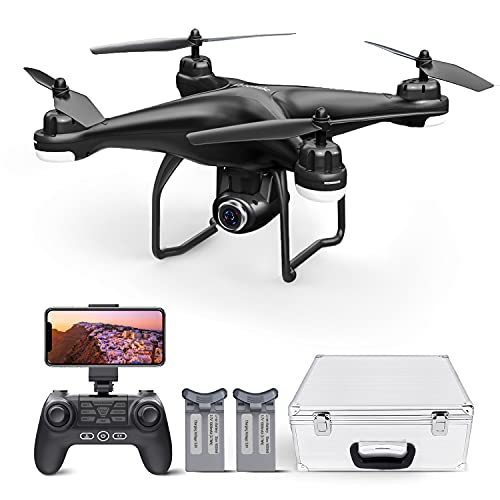
- Flight Time: 20 minutes
- Range: Up to 1500 metres
- Camera Resolution: 1080p HD
- Weight: 525g
The Potensic D85 is a multi-purpose, midrange drone that can fill a variety of roles. Thankfully, it does videography quite well, thanks to the 2K resolution camera with 120-degree FOV it has installed.
The wide-angle lens makes the D85 a good landscape videography drone. You can take breathtaking shots that are more pronounced with a wider angle. It’s also great for tighter shots, as it gives you much more room to pan and zoom the footage during editing.
The biggest downside of the camera, though, is the lack of a gimbal. This makes the video output especially prone to jerky movement and “handheld camcorder” syndrome. With the D85, you need to be more careful with your flying movements.
But the D85 has a hidden spec that most videography drones don’t have – speed. This drone is capable of a max speed of 50 km/h (which actually makes it an above-average racing drone).
This is great for making the most of your video runs. Recording your video at high speeds also gives a sense of excitement and dynamism to your footage, and will lead to exciting results.
Fortunately, not only is the D85 fast, but it also has excellent handling as well. The controls are responsive and allow you precise control over your drone.
If you prefer not to fly manually, you have a host of autonomous flight modes at your disposal. GPS Return is a vital feature, and makes your drone return to its origin point when it gets critically low on battery, or if it loses your signal.
Other intelligent modes include Follow Me and Custom Flight Paths.
In our opinion, the Potensic D85 is a decent video drone, but it can be much more than that. It can double as a fun hobbyist drone, and it even does photography right. It’s this flexibility at the lower-middle price that makes the D85 really shine.
+ Pros
- Cons
This dirt-cheap drone has a variety of features including 2K video recording.
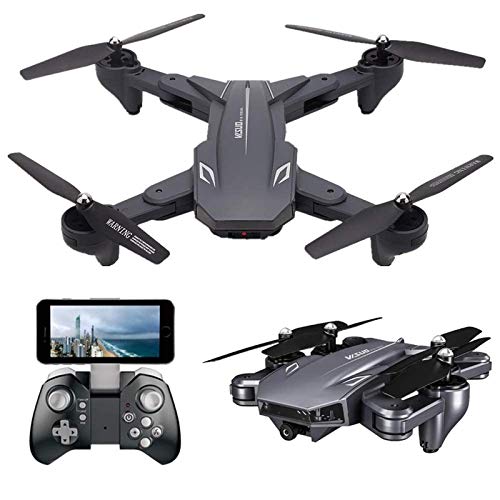
- Flight Time: 20 minutes
- Video: 2K HD
- FPV feed: 4K HD
- Gimbal: none
- Weight: 710g
The DJI Mavic has been the drone to beat for quite some time, and it’s evidenced by the number of other drone manufacturers it inspired design-wise and with features, too.
The Visuo XS816 is one such drone. And the fantastic thing about it is the surprisingly low price tag (seriously, check out the price on Amazon).
The drone is equipped with a 2K resolution video camera with support up to 50x zoom, that’s capable of producing reasonably clear videos. It’s not DJI quality, but it’s definitely better than the same drones in its class. It’s also not a DJI price tag.
Where the XS816 is worth getting, aside from how affordable it is, is in the extensive features it offers. And it’s a pretty long list.
First, it’s a lightweight foldable drone made with ABS plastic, which makes it very portable. Three seconds is all you need to pack and unpack the XS816.
Beginners will have lots of fun with its newbie features. The Auto Hover feature allows the drone to steady itself thanks to an onboard barometer. One Key Return will make it return safely to its origin point, and Headless Mode makes it easier to fly. It also supports gesture commands to take photos.
You can do aerial shows with it using the 3D Flip feature. It has FPV support, so you can view it from your drone’s perspective via the mobile app. You can fly faster with three adjustable speed modes. It also has LED lights for safer flights at night.
We could go on. The Visuo XS816 will make you rethink how many features can fit into a budget drone.
The main things that lets this drone down is its lack of gimbal for camera stabilization and its poor build quality. It feels like a cheap product (which it is, but still). We’re not too confident that it would fare too well in the event of a big crash.
+ Pros
- Cons
Our number one Follow Me drone pick for aspiring videographers and photographers.
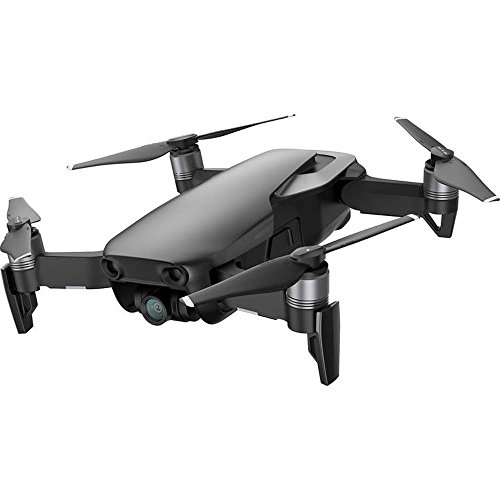
- Follow Me Method: visual recognition using DJI ActiveTrack
- Flight Time: 21 minutes
- Camera: 4K video at 30 fps, with support for 32 MB panoramas and HDR photos
- Weight: 15.16 ounces
The Mavic Air is DJI’s take on an ultra-portable, take-anywhere drone. It combines the power of its more powerful older brother, the Mavic, with the portability of the Spark.
For one, it’s exceptionally compact at less than a pound. It folds nicely into a package that you can easily fit into your backpack. And when action calls, simply unpack and launch.
Now let’s talk about this drone’s Follow Me mode. The Mavic Air uses a much-improved version of DJI’s proprietary ActiveTrack technology. It’s capable of actively tracking up to 16 subjects simultaneously, with a higher degree of precision. Even when your target is zipping and zooming around, the Mavic Air seems to be able to lock on to it.
Within ActiveTrack, you have further options on how you want Follow Me to work. For instance, you can try Trace mode, which maintains a fixed distance between the drone and the target.
The cool thing about ActiveTrack is that it also includes obstacle avoidance. If it detects an obstacle while in Follow Me mode, it will change its altitude until it stays clear of the obstruction. After that, it will continue to keep on track and follow the subject.
Overall, the DJI Mavic Air has one of the most advanced Follow Me features in the market. This is on top of its excellent camera quality, durable construction, and tons of flight options.
The Mavic Air is indeed the ultimate travel drone that’s meant to be taken to the roughest of trips, like hiking or mountain climbing.
+ Pros
- Cons
How to Choose A Video Drone For Your Needs
When you’re out shopping for the best drones for video, you’d likely hit a brick wall. That barrier is the overwhelming amount of choices you’ll get. Almost every drone out there will have a camera that can shoot video. So how do you go about picking THE one?
The first step is defining what “best” means in your current situation.
If you want a drone to record your hiking trip, then “best” would be one that’s capable of capturing decent videos autonomously. If you’re a professional videographer, then your drone should be able to capture the best video quality possible.
So, you have to narrow it down a bit. Buying a drone that “takes videos” won’t suffice anymore. It’s like going to the dealer to buy a car that drives.
With that being said, here are some things you need to consider when buying your video drone
What’s your budget?
This is probably the biggest deal-breaker into what drone you end up buying. Saying you want the best videography drone on the planet is useless if it goes beyond your budget.
That’s why we recommend setting this first. That way, when you browse, you only restrict yourself to a specific price range. This reduces the risk of you overspending.
However, not everyone, especially newbies, would have an idea on a reasonable budget range for a video drone. If that’s the case, then you can browse a bit and see the options you have. But do set a budget before you narrow down on the drone that you like.
Alternatively, we can give you a rough idea of drone pricing.
There are actually lots of drones in the below $100 category, but don’t expect them to have above-average video quality. Decent video drones generally start at around the $200 – $300 range, although there are exceptions. These will get you 720p or 1080p HD cameras, good enough for most cases. $500 will put you in the range of DJI, with better flight features and video resolution.
If you’re serious about video quality, though, then you need to go beyond the $1,000 budget cap. $1,500 will get you the best consumer video drone possible, like the DJI Mavic Pro or Phantom.
Have you flown a drone before?
This is actually a reasonable consideration because you don’t want to fly a $1,500 drone and have it just crashing down on you.
If you have no experience in flying a video drone, we recommend going for a lower-priced model first. This allows you to hone your drone piloting skills and gain the confidence to operate a more expensive drone.
By the way, if you’re looking for a practice drone, check out our recommendations for the best beginner drones.
If you absolutely can’t wait and must get a top tier videography drone, fortunately, today’s modern drones have beginner-friendly flight features. Make sure the drone you’re buying has them, like One Touch Takeoff/Landing, Auto Return, and Altitude Hold. These will reduce the chances of you crashing the drone while you’re learning the ropes.
Are you a casual video user?
It’s safe to say that a big chunk of the market wanting to buy a video drone are casual users. These are people who just want to take aerial shots while on vacation or on a trip. There’s a big chance that you fit in this category.
For casual users, camera quality is still an essential factor, but not at the top. You don’t need the highest resolution or a huge sensor size to get decent footage – midrange specs are usually enough.
What you actually want as a casual user is a drone that’s easy to operate and bring. Ideally, you’d choose a compact or foldable drone that takes minimal setup to fly, especially on trips where you’re always on the go.
Things like autonomous flight modes are also an excellent addition. These will allow you to take incredible fly-by videos with minimal control. If you travel alone, autonomous features like Follow Me are indispensable.
Are you a professional or video enthusiast?
If you’re a professional videographer or cinematographer, then you need the best camera drone that money can buy.
We’re talking about the crème de la crème of drone videography. 4K or better camera resolution, reliable video stabilization, and extended flight times. These offer the maximum video quality possible in a drone. Of course, they’re also pretty expensive.
The good news is that you don’t need to go straight to professional drones that cost thousands of dollars. A lot of consumer drones in the sub $1,000 – $1,500 space are actually pretty incredible in terms of video fidelity.

